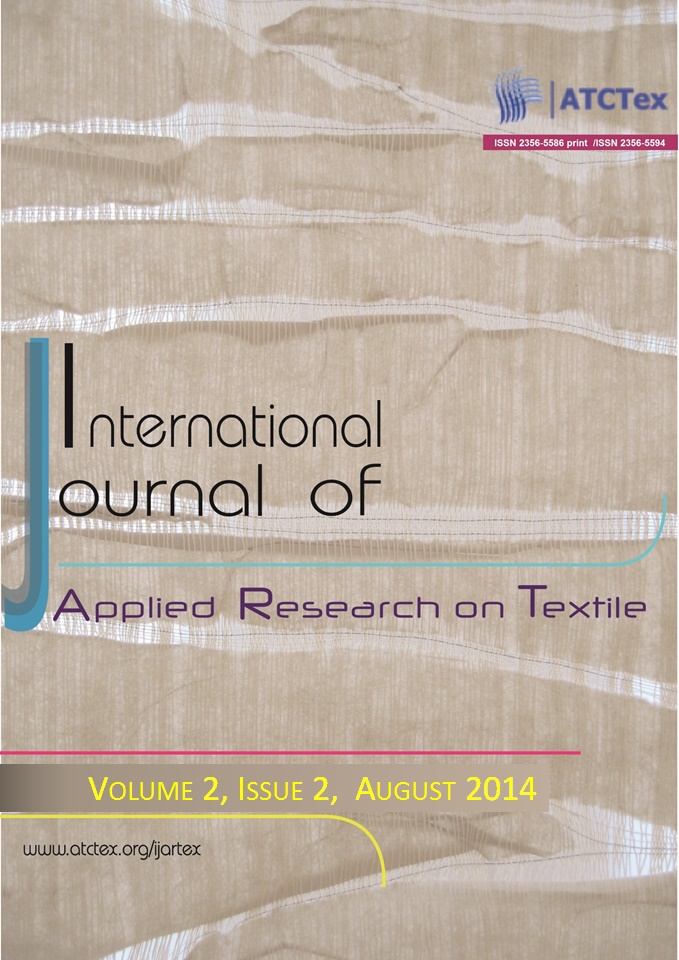ELECTROCHEMICAL REDUCTION BEHAVIOR OF VAT AND SULFUR DYES: A COMPARATIVE STUDY
MILED W1. ROUDESLI S2. HAJ SAID A2.
Corresponding author:MILED Wafa E-mail:w.miled@yahoo.fr
1TEXTILE ENGINEERING LABORATORY, UNIVERSITY OF MONASTIR, TUNISIA
2LABORATOIRE DES POLYMERES, BIOPOLYMERES ET MATERIAUX ORGANIQUES, UNIVERSITY OF MONASTIR, TUNISIA
Abstract:
In the application of vat and sulfur dyes, a large amount of hazardous by-products are generated from chemical reducing agent decomposition such as sodium dithionite and sodium sulfide. The substitution of these non-regenarable by-products by cathodically regenerable reducing agents offers great ecological advantages. In this study, indirect electrochemical reduction of the most popular Vat dye (CI Vat Blue 1) and Sulfur dyes (CI Sulfur Black 1) was studied in a divided electrochemical cell connected with a separated dye bath. The redox properties of the tested dyes were studied by the mean of potentiometry at imposed low current and by controlling the evolution of the redox potential. The colorcoordinates and the colorfastness of the samples were investigated and compared with the conventional dyeing process. The electrochemical process proposed in this study permitted an improved understanding of the dyestuff reduction behavior at a molecular level. The electrochemical reduction of CI Vat Blue 1 showed better performance. The CI Sulfur Black 1 has almost good advantage, but with different reduction behavior and more complications because of different reducible sites in its molecule..
NEW POLYMER BASED MODIFIED CYCLODEXTRINS GRAFTED TO TEXTILE FIBERS; CHARACTERIZATION AND APPLICATION TO COTTON WOUND DRESSINGS
EL GHOUL Y1. AMMAR C1. EL ACHARI A2.
Corresponding author:EL GHOUL Yassine E-mail:g_yasso2002@yahoo.fr
1TEXTILE ENGINEERING LABORATORY, UNIVERSITY OF MONASTIR, TUNISIA
2LABORATORY OF TEXTILE PROCESS AND MATERIALS, UPRES EA 2161, RESEARCH UNIT OF ENSAIT, B.P 30329, 59056 ROUBAIX CEDEX 01, FRANCE
Abstract:
This study describes the use of a new polymer based modified cyclodextrins (CDs) as a finishing agent of natural cotton fibers used in order to obtain wound dressings with improved antibacterial delivery properties. We have first synthesized the per-6-azido-β-CD and after the well known per-6-amino-β-CD was obtained via the Staudinger reduction. This synthesis was then proved by NMR and mass spectrometry characterizations.
This per-aminated primary face CD was then polymerized with a citric acid. The new polymer (polyCTR-CDNH2) yielded a cross-linked polymer that chemically bonded to the cotton wound dressing fibers and was resistant to sever water washings.
We report that the grafting rate of polymer of modified CDs functionalizing the cotton dressings was controlled by temperature, curing time and the CDs dilution of the impregnating bath.
The functionalization was then characterized by a topographic study of dressings grafted surfaces which was approached by atomic force microscopy (AFM; non-contact mode). This characterization permitted to evaluate the roughness and the chemical heterogeneity of the grafted dressing surfaces.
The grafting of the new polymer of CDs respected the original properties of treated textiles. And it can provide a functionalized medical dressing with new added properties. In fact they can be exploited to complex substances for antibacterial effect or healing purpose to facilitate the cure of the wounds. These substances will be stabilized and protected by encapsulation then they will be slowly released in contact with a wet wound.
In conclusion, these results from our study offer an insight into the efficient performance of modified CDs as drug delivery systems for multiple applications in the fields of biomaterials and medical textiles.
.
A NONLINEAR VISCOELASTIC MODEL FOR DESCRIBING FABRIC WRINKLE RECOVERY BEHAVIOUR
ZAOUALI R1. MASAHLI S1. SAKLI F1.
Corresponding author:Zaouali Raja E-mail:zaouali_raja@yahoo.fr
1TEXTILE ENGINEERING LABORATORY, UNIVERSITY OF MONASTIR, TUNISIA
Abstract:
The main objective of this paper is to study and model the relaxation behaviour of fabric wrinkle recovery. Based on the viscoelasticity theory of textile materials and in order to describe the viscoelastic behaviour of wrinkle recovery, we proposed a rheological model and we studied the correlation between experimental and theoretical creep-recovery curves. The creep-recovery equation of Burger’s model describes well the relaxation behaviour of wrinkle recovery according to the time. The proposed nonlinear viscoelastic model permitted us also to evaluate the components of elastic, viscoelastic and plastic deformation of the different wrinkled fabrics..
INFLUENCE OF FINISHING PRODUCTS ON SEWING NEEDLE PENETRATION FORCE
MANSOURI S1. CHAABOUNI Y2. CHEIKHROUHOU M2.
Corresponding author:mansouri samar E-mail:samar20481@yahoo.fr
1RESEARCH UNITY OF APPLIED CHEMISTRY
2TEXTILE ENGINEERING LABORATORY, UNIVERSITY OF MONASTIR, TUNISIA
Abstract:
The present paper describes the influence of finishing products on needle penetration force during sewing. The variation of the needed force to pass through woven fabric is an important parameter to be checked. It is strongly depended on the characteristics of textile supports. As a result, varying structural properties of used samples can change the measured force values. So using only one fabric and varying the concentration of the products, would make it possible to clear up well the effect of the finishing products on the fabric resistance to needle penetration operation. Various treatments were applied such as mercerizing, water proofing, wash and wear, stiffening and softening. Many encouraging results were established. In that such parameter decreased in the case of using products improving threads movement for instance the softening products. However, it rose when making films on the fabric surface for example the waterproofing process.
.
STUDY ON PERFUME SUSTAINED-RELEASE FROM COTTON FABRIC TREATED WITH POLYSTYRENE MICROSPHERES
AZIZI N1. LADHARI N3. CHEVALIER Y2. MAJDOUB M1.
Corresponding author:AZIZI Nedra E-mail:azizinedra@yahoo.fr
1Laboratoire des Interfaces et Matériaux Avancés (LIMA), Faculté des Sciences de Monastir, Université de Monastir, bd de l’Environnement, 5019 Monastir, Tunisia.
2Laboratoire d’Automatique et de Génie des Procédés (LAGEP), Université Claude Bernard Lyon 1, UMR CNRS 5007, 43 bd du 11 Novembre 1918, 69622 Villeurbanne Cedex, France.
3TEXTILE ENGINEERING LABORATORY, UNIVERSITY OF MONASTIR, TUNISIA
Abstract:
ABSTRACT
Encapsulation is a suitable way to control fragrance release and to make perfumed textiles more durable. Polystyrene-based microparticles containing fragrance were produced by in-situ polymerization technique with neroline as a core material and polystyrene as wall material. The chemical structure of the microspheres was confirmed by IR and 1H NMR spectroscopies. Spherical shape and particle size distributions of microparticles were revealed by means of optical microscopy, scanning electron microscopy (SEM) observations and small-angle light scattering measurements. The encapsulation efficiency of perfume, determined by using 1H NMR analysis, accounts for 55%. Neroline-loaded microspheres have been investigated for their properties and their suitability for cosmetotextile applications. The microspheres were deposited onto cotton fabrics by an impregnation process with about 76 % yield. The durability and the perfume release behaviour of the impregnated textile were evaluated through SEM observations and UV-visible spectroscopy.
.



